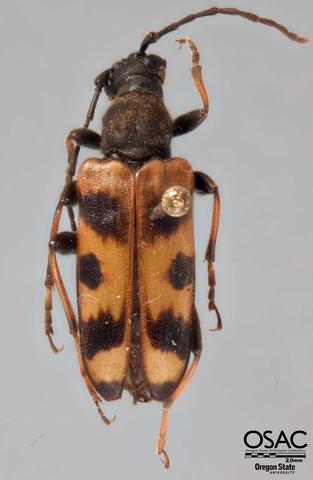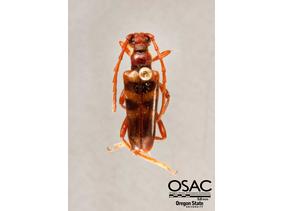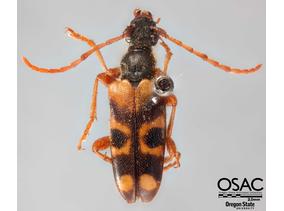You are here
Lepturinae
Xestoleptura Casey, 1913
Nomenclature
-
Subfamily: LepturinaeTribe: Lepturini
SUMMARY
Xestoleptura is represented by 9 species worldwide, 6 of which occur in North America. One species, X. octonotata is broadly distributed in Eastern North America, X. cockerelli occurs on the Colorado Plateau, and 4 species are found on the North American west coast. The species X. rufiventris (Gebler), X. baechmanni (Plavilstshikov), and X. nigroflava (Fuss), recently transferred from the genus Anoplodera, occur in Europe and Asia (Miroshnikov, 1998; Kadlec, Hajek, 2005).
Diagnosis. The genus Xestoleptura is one of several diurnal Lepturine genera from the tribe Lepturini recognizable for its species' yellow and black-striped elytra. Xestoleptura can be distinguished from Dorcasina, Judolia, Leptura, Stenostrophia, Strophiona, and Typocerus by its distinctive pronotum, which is convex and subequal to the width of the head, deeply constricted dorsally at both the anterior and basal margins, and has the basal margin strongly sinuate and rounded at the lateral angles. The constrictions of the pronotum will also distinguish Xestoleptura from Brachyleptura vexatrix, which also has a narrow pronotum and similar color patterning. The elytra are in Xestoleptura strongly bilobed at the base, especially in is crassipes and crassicornis. On the global scale, Miroshnikov (1998, figs. 26-39) has made a convincing case for the generic concept of Xestoleptura based on the morphology of the male genitalia, which have the parameres distinctively notched on the inner angles.
The Pacific Northwestern species (bold) and their junior synonyms (italics) are as follows:
behrensii (LeConte, 1873:227)
crassicornis (LeConte, 1873:227)
corusca Casey, 1913:261
crassipes (LeConte, 1857:65)
xanthogaster LeConte, 1859:88
fasciventris LeConte, 1861:355
crassipes shastana Casey, 1913:263
muliebris Casey, 1913:263
vancouveri Casey, 1913:263
tibialis (LeConte, 1850:236)
hirtella LeConte, 1873:226
columbica Casey, 1913:261
miquelonensis Pic, 1922:11
pictipennis Casey, 1924:285
Xestoleptura behrensii (photo coming soon) -- Somewhat rare. Ranges from British Columbia to California. This species can be separated from X. crassicornis and X. crassipes by its antennae, which are narrow and do not have the segments expanded apically. The males may look similar to X. tibialis but are narrower posteriorly and have the basal punctures of the elytra somewhat sparse. The basal elytral punctures in tibialis are separate but densely clustered.

Xestoleptura crassicornis (above) -- This species is very similar in appearance to X. crassipes. Males of crassicornis have the antennal apices strongly expanded, nearly sub-serrate (weakly expanded in crassipes) . There are often four transverse elytral bands, (anterior bands meet at oblique angle in crassipes). Linsley and Chemsak (1976) report some individuals with elytra entirely black except for the basal portion of the elytra yellowish. The majority of the 27 specimens available for study at the Oregon State Arthropod Collection have the pronotum orange, with a few specimens bearing dark orange- to reddish black pronota.
Relatively little is known about the habits of crassicornis. Linsley and Chemsak (1976, p. 156) report the species' range from Washington to Idaho and Sierra Nevada to Southern California, and flight period from July to September. Pinus and Abies have been recorded as host plants. Flower records are Cirsium, Gayophytum, and Chrysolepsis.
In August of 2013, the author found several populations of X. crassicornis crawling around on the leaves of blue elderberry (Sambucus nigra cerulea) at high elevation in the Warner Mountains of Northern California. No individuals were observed on the elderberry flowers, however three were observed clustered and feeding at an open wound on the base of a 1 cm green stem. The anomalous North American genus Desmocerus is the only other lepturine known to feed on the leaves of Sambucus, which is its obligate host. Sambucus is known to contain cyanogenic glucocides, and it has been speculated that the brightly-colored species of Desmocerus sequester these as defensive chemicals. It is possible that the Xestoleptura of the Warner Mountains are following a similar strategy.

Xestoleptura crassipes (above)-- Males with antennal apices weakly expanded. Elytra distinctly punctate and pubescent (sparsely in crassicornis). Elytral pattern appears to be variable within populations, but the description provided by Linsley and Chemsak (1976) should provide for a more confident identification:
[The male elytra] varies from all black apical one-third and well-developed post humeral spots to no posthumeral spots, median spots reduced, a transverse band at apical one-fourth and narrowly black apices. The antennae are usually dark in males and yellowish in females. Usually the females have a median band, pre-apical band, and apices narrowly black. The basal band is usually reduced to two post-humeral spots.
Linsley and Chemsak also report that the hind tibiae of males have the inside spur modified into a plate. This modification has only been observed occasionally on the specimens of the Oregon State Arthropod Collection.


Xestoleptura tibialis (above) can be identified by its black femora, narrowed, darkened antennae, and the characteristic elytral pattern, which is typically reduced to two lateral spots in males. (The elytral patterning in females of tibialis are occasionally more extensive, as in the picture above). This species looks similar to Leptura obliterata, but can be separated by the characters of the pronotum. The basal lateral angles of the pronotum in Leptura are pointed and expanded laterally to wrap around the humeral "shoulder" angles of the elytra.
Works Cited
- Casey, T. L. 1913. Further studies amongst the American Longicornia. Memoirs on the Coleoptera, 4:193-388. <Link to Biodiversity Heritage Library> <PDF>
- Casey, T. L. 1924. Additions to the known Coleoptera of North America. Memoirs on the Coleoptera, 11:1-347. <Openlibrary.org> <PDF>
- Kadlec S., Hájek J., 2005. Xestoleptura nigroflava, a new genus of longhorn beetles for Europe (Coleoptera: Cerambycidae: Lepturinae). 1 colour plate, 6 pp. [FHC207] Folia Heyrovskyana 12(A)(4): 161-166.
- LeConte, J. L. 1850. General remarks upon the Coleoptera of Lake Superior. pp. 201-242. In: Agassiz, J.L R. Lake Superior: its physical character, vegetation, and animals, compared with those of other and similar regions, with a narrative of the tour, by J. Eliott Cabot. And contributions by other scientific gentleman. Boston: Gould, Kendall and Lincoln. x +428 pp. + 8 pl.
- LeConte, J. L. 1857. Report upon Insects collected on the survey. In, Report of Explorations and Surveys to ascertain the most practicable and economical route for a railroad from the Mississippi river to the Pacific Ocean. Made under the Direction of the Secretary of War, in 1853-5, according to Acts of Congress of March 3, 1853, May 31, 1854 and August 5, 1854, 12:1-72, 2 pls. <Making of America Books> <pg.65.gif>
- LeConte, J. L. 1859. Catalogue of the Coleoptera of Fort Tejon, California. Proceedings of the Academy of Natural Sciences of Philadelphia, 11:69-90. <Link to BHL> <PDF>
- LeConte, J. L. 1861. New species of Coleoptera inhabiting the Pacific District of the United States. Proceedings of the Academy of Natural Sciences of Philadelphia, 13:338-359. <Link to BHL> <PDF>
- LeConte, J. L. 1873. New species of North American Coleoptera. Prepared for the Smithsonian Institution. Part II. Smithsonian Miscellaneous Collections. 11(264):169-240. <Link to BHL> <PDF>
- Linsley, E.G. and J.A. Chemsak. 1976. Cerambycidae of North America. Part VI, No.2. Taxonomy and Classification of the Subfamily Lepturinae. University of California Publications in Entomology 80, 186 pp.
- Miroshnikov, A. I., 1998: A new classification of longicorn beetles of the Anoplodera complex, tribe Lepturini Coleoptera, Cerambycidae of Holarctic fauna. I. Entomologicheskoe Obozrenie 77(2): 384-420. [English Translation: Entomological Reivew, Vol. 78, No. 4, 1998, pp. 437--465.]
- Pic, Maurice. 1922. [title not verified]. L’Échange, 37(405):11.





